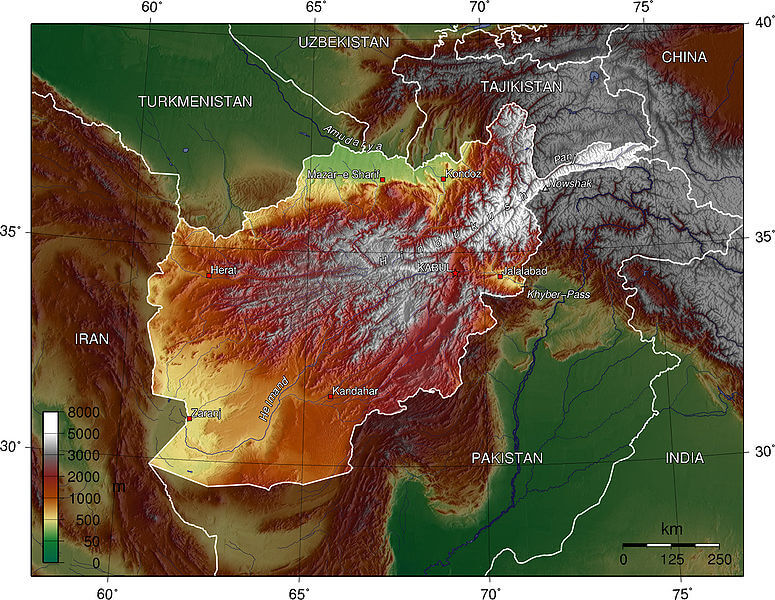Afghanistan Map
Explore Afghanistan on our interactive map. Discover its rugged terrain, rich history, and diverse culture. Afghanistan map allows you to zoom in and out, search for specific locations, and toggle between different map layers. Use it to plan your trip, research Afghan geography, or learn more about this fascinating country.
Afghanistan Map FQA
How many cities are in Afghanistan ?
Afghanistan has over 50 cities. Largest 10 by population: Kabul, Kandahar, Herat, Mazar-i-Sharif, Jalalabad, Kunduz, Ghazni, Balkh, Baghlan, Taloqan.What are the major geographical features of Afghanistan ?
Afghanistan is a landlocked country dominated by the rugged Hindu Kush mountains, with high peaks and deep valleys. It also features desert regions, river valleys such as the Helmand and Amu Darya, and fertile plains in the north. The country has a varied geography with arid plateaus and mountain passes.AFGHANISTAN COUNTRY REGIONS MAP

MAP OF AFGHANISTAN

AFGHANISTAN LAGE MAP

Can I download a high-resolution map of Afghanistan ?
Yes. Download high-resolution political and physical maps of Afghanistan for personal or educational use. Redistribution is subject to the terms of our license.Where is located Afghanistan on the Map
Afghanistan is a landlocked country located in South Asia and Central Asia. It is bordered by Pakistan to the east and south, Iran to the west, Turkmenistan, Uzbekistan, and Tajikistan to the north, and China to the northeast. The country's geography is characterized by rugged terrain, with mountain ranges dominating much of the landscape. To find Afghanistan on a map, you can look for the coordinates 33.9391° N, 67.7100° E.
Afghanistan is a country located in South Asia, bordered by Pakistan to the east and south, Iran to the west, Turkmenistan, Uzbekistan, and Tajikistan to the north, and China to the northeast. It has a rich history that spans over 5,000 years, with various empires and kingdoms leaving their mark on the region.
On this page, you can explore Afghanistan through an interactive map that allows you to zoom in and out, search for specific locations, and toggle between different map layers. Whether you're planning a trip to Afghanistan or simply curious about this fascinating country, our map can help you discover all that Afghanistan has to offer.
From the rugged terrain of the Hindu Kush mountains to the sprawling cities and historic landmarks, Afghanistan has a unique and diverse culture that is shaped by its geography and history. Despite its challenges, Afghanistan is a place of great beauty, resilience, and hospitality.
For more about Afghanistan >>
Brief information about Afghanistan
Afghanistan is a landlocked country located in South Asia, bordered by Pakistan, Iran, Turkmenistan, Uzbekistan, Tajikistan, and China. It has a population of around 38 million people and its capital city is Kabul.A Collection of Afghanistan Maps and Afghanistan Satellite Images
AFGHANISTAN COUNTRY REGIONS MAP

MAP OF AFGHANISTAN

AFGHANISTAN LAGE MAP

AFGHANISTAN ADMINISTRATIVE MAP

AFGHANISTAN AND PAKISTAN POLITICAL MAP

AFGHANISTAN MAP RESISTANCE GROUPS

AFGHANISTAN MAP PROVINCES

VECTOR MAP OF AFGHANISTAN

ISLAMIC REPUBLIC OF AFGHANISTAN MAP

3D RELIEF MAP OF AFGHANISTAN

AFGHANISTAN COUNTRY MAP

AFGHANISTAN EARTH MAP

AFGHANISTAN MAP AND FLAG

AFGHANISTAN MAP

AFGHANISTAN POLITICAL MAP WITH CAPITAL KABUL

AFGHANISTAN POLITICAL MAP

AFGHANISTAN SATELLITE AERIAL VIEW FROM SPACE

AFGHANISTAN SATELLITE AERIAL VIEW WITH NEIGHBOURS

AFGHANISTAN SATELLITE AERIAL VIEW

AFGHANISTAN SATELLITE MAP

AFGHANISTAN VINTAGE MAP

AFGHANISTAN MAP

AFGHANISTAN MAPS

AFGHANISTAN POLITICAL MAP

AFGHANISTAN COUNTRY BORDERS MAP

AFGHANISTAN GEOGRAPHIC MAP

AFGHANISTAN GEOGRAPHY MAP

AFGHANISTAN GOOGLE MAP

AFGHANISTAN MAP MAJOR GROUPS

AFGHANISTAN MAP NATO

AFGHANISTAN MAP PHYSICAL

AFGHANISTAN POLITICAL MAP

AFGHANISTAN PROVINCES MAP

AFGHANISTAN TALIBAN DOSTUMS MASSOUDS MAP

AFGHANISTAN TOPOGRAPHY MAP

MAP OF THE ISLAMIC REPUBLIC OF AFGHANISTAN

MAP AFGHANISTAN

MAP OF AFGHANISTAN

POLITICAL MAP OF AFGHANISTAN

SHADED RELIEF MAP OF AFGHANISTAN

US ARMY MAP OF AFGHANISTAN

VECTOR MAP OF AFGHANISTAN WITH IMPORTANT CITIES

WHERE IS AFGHANISTAN IN THE WORLD

- Head of Performance Marketing
- Head of SEO
- Linkedin Profile: linkedin.com/in/arifcagrici


